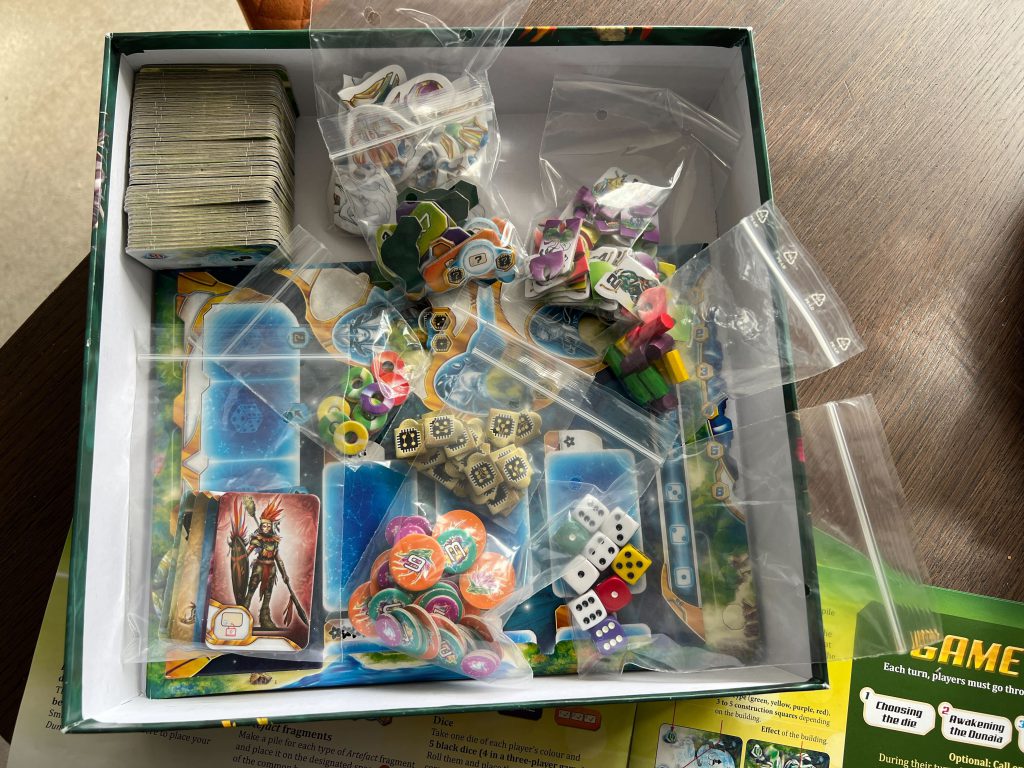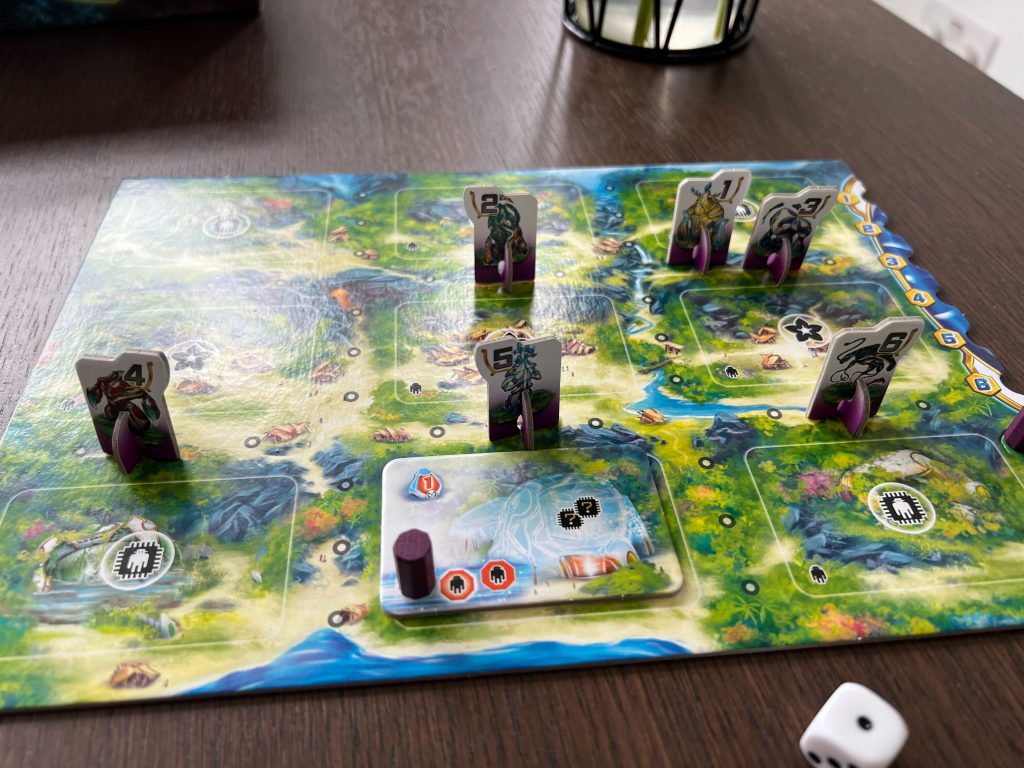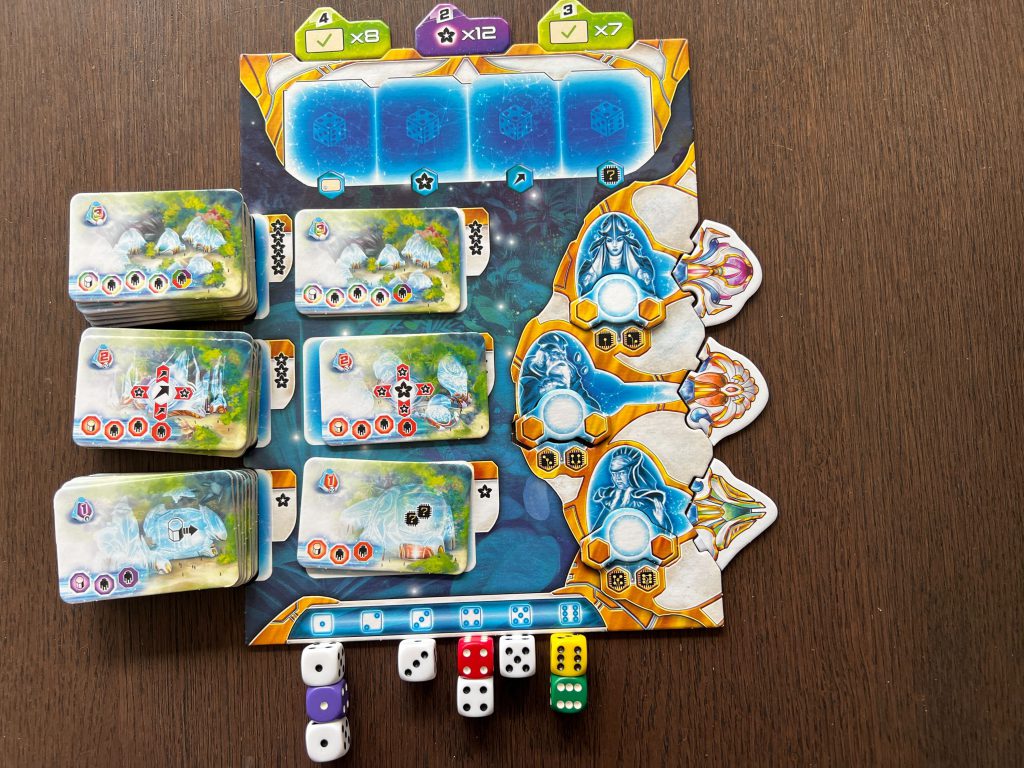Dunaïa is an engine builder about racing to fulfil a mystical prophecy
In Dunaïa players carefully draft dice in a race to secure their tribes’ future through using the titular metal beings to best position themselves before the three prophecies come to pass.
Dunaia is a clever dice-drafting game with tight turns and relatively easy score-tabulating that I’d probably if pushed, describe as a mid-tier engine builder. It’ll apparently take about an hour to play and is designed for two to four players, although clearly intended to work best with three or four.

Each player receives their own 9-tile play area, while a central, shared play area serves as a shop and resource pool for the duration of the game. There are pools of metal flower tokens, colour tokens, artefact fragments and building tiles. There are also elder powers and prophecy tiles which are picked at the start of the game. Finally, players have their own pool of Dunaia, construction tokesn and player chips. Once everything is split out, gameplay begins and it’s actually refreshingly simple. A player (the wisest, apparently) rolls the dice and sets them up underneath the common board, the flip over the first of the level 1, 2 and 3 buildings and put them in the appropriate slots, which creates a six-building storefront.
The active player then takes the black dice and then place the associated Dunaia on a slot between building-slots on their board, completing any adjacent tile instructions. If there are no black die left they take the one of their colour, if that’s not there — because it’s been spent — then they reroll the pile (inc. 5 black die, so the dealer shifts between rounds) and then pick a black die of their choosing. Once they’ve placed their Dunaia and completed any relevant awakening steps they place their die onto a recycling tile. Recycling phases are either completed level 1 buildings, including rival tribes’ ones, or the empty space on the common board. Level 1 buildings allow you to spend metal flowers on resources, if you don’t own the building that’s fine, you just have to pay the owner instead. This causes an early rush to claim these, as black flowers are a great shortcut to unlocking things without needing to reposition Dunaia.

Level 2 buildings offer ‘Awakening’ bonuses, which can stack if you align them carefully with buildings of the same colour, while Level 3 buildings give you major bonuses to victory points if you can, similarly, match colours to adjacent buildings. All in all, there’s plenty of room, through ‘recycling’ the dice, and the three building types, for each player to try and take a different route to victory.
Once you’re done recycling your die then you do a quick check to see if you’ve triggered a prophecy, if you have then you gain that token, if not, or if it’s the first or second prophecy triggered, then play continues.
There is one extra thing that you can do. At any point during your turn, you can spend memory chips (which are earned through buildings or Dunaia placement) to appease your elders. These give you big boons like allowing you to advance construction faster, or move your workers around the board, and can really make a difference to the game. However, specific chips are needed for each boon, and you can only have one instance of each on your board at once, so it makes it more of a sneaky ‘gotcha’ moment for people to slowly build up to.

Victory comes for the player who has the most points (a total of building value, metal flowers and points for completing prophecies) which can really come down to the line based on the colour-pairing mechanics that come into play with the third level buildings.
My favourite about it, though, is the fact that you have a reserved dice to spend last in the dice pool. This means that if you are rolling the whole set and your dice is a 2, but the five black dice are 2, 6, 3, 4, 1, then you know that you’re moving Dunaia number 2 at least once, so can ignore the black-2 die and build your strategy around moving as your final move in the round.
There’s a really cool sci-fi, ‘robots meets tribal’ theme that makes for an interesting colour palette for the board. Despite that, it never really gets too busy. Once you grow a little numb to that though this very much becomes a game about putting colours next to each other, but one with a clever twist on dice drafting.
Dunaia is exactly the kind of game that somebody who enjoys the processes of Catan or Splendor should move onto, and it might replace one of those in a regular play pattern.
Dunaia is available now from various online retailers, including Amazon.
Comments are closed.